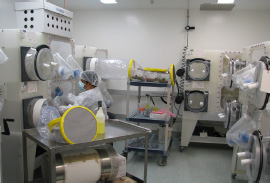Germ-Free Mice
New Facility for Microbe Study
Some 100 trillion beneficial microorganisms—bacteria, fungi, and viruses—populate your body inside and out. Many species keep us healthy by helping with digestion, producing nutrients, and strengthening the immune system. But what would happen if we didn’t have this assortment of beneficial, or commensal, microbiota living within us? To find out, NIH scientists are studying germ-free mice that have not been naturally colonized by microorganisms.
NIAID is home to one of the few facilities in the United States that houses so-called gnotobiotic mice. These mice are born in germ-free conditions, and investigators control the microbiota by inoculating the animals with specific microorganisms. The word “gnotobiotic” comes from the Greek words gnostos, for known, and bios, for life.
When the field of commensal research exploded in the mid-2000s, many NIH investigators already were conducting research on microbiota. “But there were very few intramural resources available for studying commensals [at NIH],” said NIAID senior investigator Yasmine Belkaid. “It became obvious we needed a germ-free animal facility to support investigations on campus.”

Photo: NIAID
In NIAID’s gnotobiotic mice facility, technicians handle the germ-free animals with gloves attached to isolators.
Belkaid got her wish soon enough. In July 2008, investigators and staff in NIAID’S Comparative Medicine Branch (CMB), directed by veterinarian Randy Elkins, identified facilities in which to house germ-free mice. They then purchased 12 isolators that contain five cages each; each of the 60 cages is capable of housing five mice. The National Gnotobiotic Rodent Resource Center at the University of North Carolina-Chapel Hill provided training in how to care for, maintain, and conduct research with these germ-free mice.
Research has since spread faster than germs across the NIH through collaborations with NIAID researchers. For example, Belkaid’s group is working on projects with senior investigators Julie Segre at NHGRI and Giorgio Trinchieri at NCI.
Segre, who leads the NIH Human Microbiome Project, studies the role of the skin as a barrier between the body and the environment. Her project with Belkaid involves exploring the relationship between the immune cells and bacteria at the skin barrier.
Trinchieri’s lab aims to understand how gut flora affect the pathogenesis of inflammation and immune colitis (inflammation of the colon or large intestine) and, in mouse models, of colitis-associated cancer. By studying germ-free mice that are deficient in immune- or inflammation-related genes and inoculating them with defined flora, his lab can distinguish between the effects of genes and the role of commensals.
The research is not without its challenges. Gnotobiotic mice are born and raised in sterile conditions. At birth, they are removed from the mother by Caesarean section and live in the isolators with germ-free foster mothers. Investigators must perform all experiments using gloves attached to the isolators so that the animals never come into accidental contact with germs other than those that are deliberately introduced.
The NIAID Gnotobiotic User Committee—made up of veterinarians, investigators, and CMB staff—establishes requirements for working in the facility, maintaining the isolators, and monitoring the status of germ-free and other animals that must be maintained in isolators. The committee also developed a procedure for submitting proposals to use the gnotobiotic mice.
NIAID’s gnotobiotic facility is home to three strains of mice, and more are being generated. Fifteen projects conducted by five NIAID labs have relied on these germ-free mice. Belkaid and Elkins hope to expand the gnotobiotic facility and begin an in-house breeding program. There also are plans to establish a consortium of germ-free mice facilities across the United States, which will enable NIH to share strains and breeding pairs with others.
For more information:
This page was last updated on Monday, May 2, 2022
